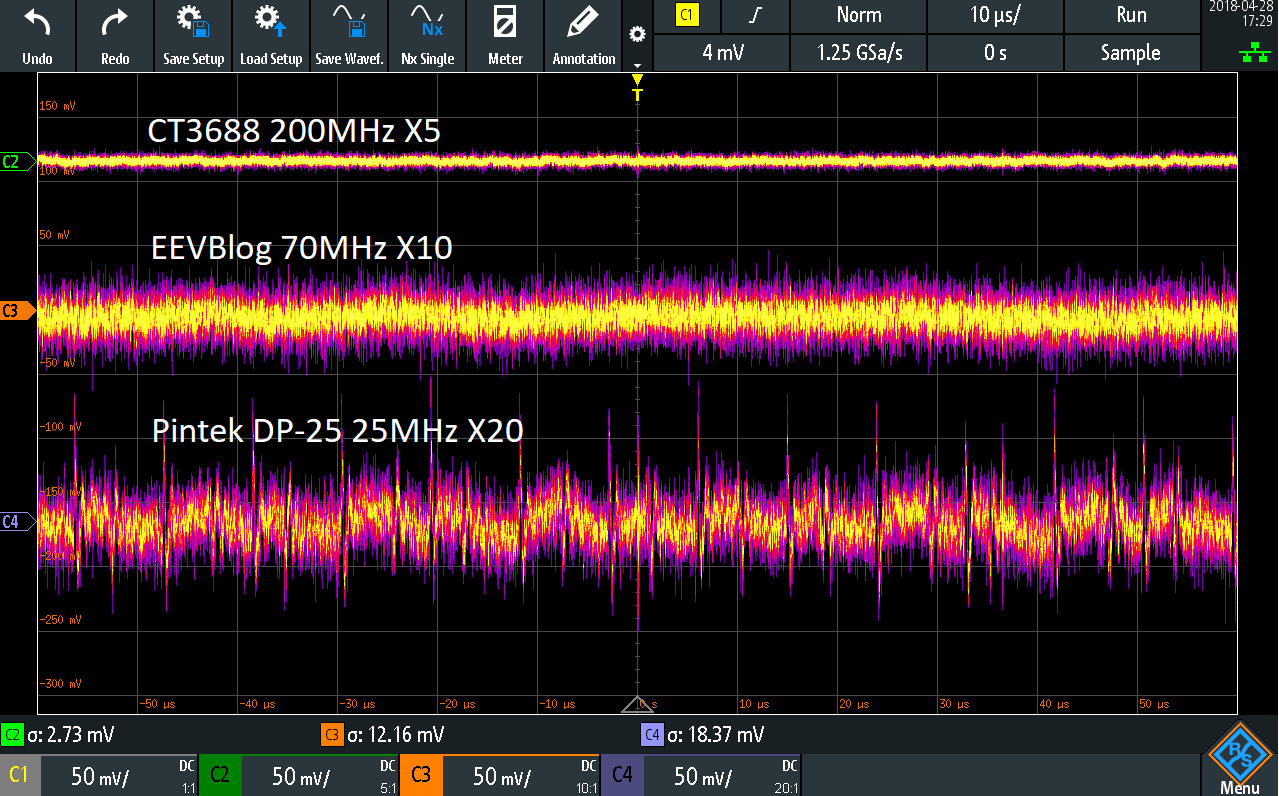Nice info on the Tek and Agilent probes, thanks. These are bulky with the power supplies but used, are very decently priced for the specs and quality.
Anyone knows the noise characteristics of these?
if you are talking about 1141. attached are the noise figures for my 1141 at different 1X, 10X, 100X (i dont have 10X attn but i bet my bottom dollar on that), is it within spec or outside? i'm not sure i bought it damaged (well not really, the output coax is just disconnected when i got it, all i did is resolder it).
±10mVpp @ 1X, ±100mVpp @ 10X, ±1Vpp @ 100X. you see, its just multiplication of each other. noise figure at no (1X) attenuation is just = 1/10X noise figure at 10X attenuation, and noise figure at 100X attenuation is just = 100X of noise figure at no attenuation etc. because simply the DSO just scale it in FW according to probe attenuation setting in the DSO. where the diff probe is outputting the same noise figure regardless of attenuation used. the 4th attachment is i tried change the scale based on your test in the another thread at no attenuation of 1141.. i can say 1141 is a winner if i want to (below is comparison i added my 1411 result on top) but we cant because its not apple to apple comparison... (my test is not in a clean room so there sometime larger or lower noise going on, and shorting the probe doesnt make any difference, so i left the probe disconnected)


to make apple to apple comparison we need to see noise figure at the same attenuation level (or precisely at the same max diff input, or the same common mode) imho, because different probe is for different purpose. although CT3688 is the least noise figure, but it cannot do mains work (±100V - ±300V++ common mode), it might be suitable for the OP though since only probing USB.
for other probe like EEVBlog, we can use for mains work but at X100 attenuation, meaning 10X the noise figure in your chart (±0.25Vpp from eyeballing it). the same applied to DP-25. both probe will be suitable for large differential signal probing on mains. and it also applicable to the OP, if all he want is differential signal of the USB (±5V), noise will be lowered since he will set the DSO at high V/div anyway. but to probe low diff signal at high (mains) common mode such as high side BJT's Vbe in range of 0.3V, all three will not do the work nicely. CT3688 will exceed its rating, EEVBlog and DP-25 signal will be swarmed by larger noise figure esp Pintek DP-25. 1141 will be nicer in this regards (at 10X attenuation, ±3V max differential input ±500V common mode, noise of 1141 is ±0.1Vpp), but for OP purpose, he has to use 100X attenuator with 1141 to see the ±5V signal, but at larger noise ±1Vpp. noise will be noticable on the DSO but averaging may help, its just when the intended diff signal very close to noise floor, its more difficult even with averaging. otoh if you need larger than ±30V differential input, than 1141 is out of the league. ymmv.
edit: sorry i forgot to mention the spec for 1141 (refer to 5th pic for input voltage spec page 55 from
https://cdn.testequity.com/documents/pdf/1142A-ug.pdf):
no attenuation: max diff signal is ±0.3V, max common mode Vdc is ±200V
10X attenuation: max diff signal is ±3V, max common mode Vdc is ±500V
100X attenuation: max diff signal is ±30V, max common mode Vdc is ±500V
and another think... other spec like input impedance also need to be considered, CT3688 has the lowest among all, so less ideal for high impedance node probing. i think why CT3688 can get lowest noise is because it doesnt have adjustable attenuator, so the designer can strive for lowest noise signal possible from input to output, other probe may have exposed big switch, so difficult to get the noise lower, ymmv. fwiw...